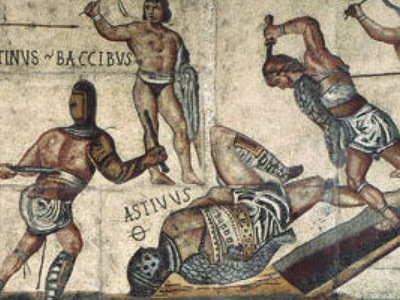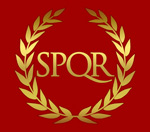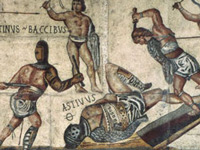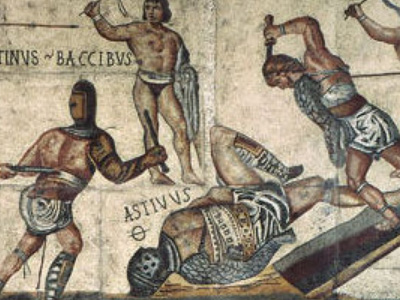Third Servile War (73-71 BC)

The Third Servile War, also called by Plutarch the Gladiator War and The War of Spartacus, was the last in a series of slave rebellions against the Roman Republic The Roman Republic was a form of government of Rome and the era of the classical Roman civilization when it was run through public representation of the Roman people. Beginning with the overthrow of the Roman Kingdom (traditionally dated to 509 BC) and ending in 27 BC with the establishment of the Roman Empire, Rome's control rapidly expanded during this period - from the city's immediate surroundings to hegemony over the entire Mediterranean world., known collectively as the Servile Wars. The Third was the only one directly to threaten the Roman heartland of Italia. It was particularly alarming to Rome because its military seemed powerless to suppress it.
The Roman Republic was a form of government of Rome and the era of the classical Roman civilization when it was run through public representation of the Roman people. Beginning with the overthrow of the Roman Kingdom (traditionally dated to 509 BC) and ending in 27 BC with the establishment of the Roman Empire, Rome's control rapidly expanded during this period - from the city's immediate surroundings to hegemony over the entire Mediterranean world., known collectively as the Servile Wars. The Third was the only one directly to threaten the Roman heartland of Italia. It was particularly alarming to Rome because its military seemed powerless to suppress it.
The revolt began in 73 BC, with the escape of around 70 slave-gladiators from a gladiator school in Capua; they easily defeated the small Roman force sent to recapture them. Within two years, they had been joined by some 120,000 men, women and children; the able-bodied adults of this band were a surprisingly effective armed force that repeatedly showed they could withstand or defeat the Roman military, from the local Campanian patrols, to the Roman militia, and to trained Roman legions under consular command. The slaves wandered throughout Italia, raiding estates and towns with relative impunity, sometimes dividing their forces into separate but allied bands under the guidance of several leaders, including the famous gladiator-general Spartacus.
The Roman Senate grew increasingly alarmed at the slave-army's depredations and continued military successes. Eventually Rome fielded an army of eight legions under the harsh but effective leadership of Marcus Licinius Crassus. The war ended in 71 BC when, after a long and bitter fighting retreat before the legions of Crassus, and the realization that the legions of Gnaeus Pompeius Magnus and Marcus Terentius Varro Lucullus were moving in to entrap them, the armies of Spartacus launched their full strength against Crassus' legions and were utterly defeated. Of the survivors, some 6,000 were crucified along the Appian way.
Plutarch's account of the revolt suggests that the slaves simply wished to escape to freedom, and leave Roman territory by way of Cisalpine Gaul. Appian and Florus describe the revolt as a civil war, in which the slaves intended to capture the city of Rome itself. The Third Servile War had significant and far-reaching effects on Rome's broader history. Pompey and Crassus exploited their successes to further their political careers, using their public acclaim and the implied threat of their legions to sway the consular elections of 70 BC in their favor. Their subsequent actions as Consuls greatly furthered the subversion of Roman political institutions and contributed to the eventual transition of the Roman Republic into the Roman Empire The Roman Empire was the post-Republican period of ancient Rome. As a polity, it included large territorial holdings around the Mediterranean Sea in Europe, North Africa, and Western Asia, and was ruled by emperors. The first two centuries of the Roman Empire saw a period of unprecedented stability and prosperity known as the Pax Romana ('Roman Peace'). The Empire was later ruled by multiple emperors who shared control over the Western Roman Empire and the Eastern Roman Empire..
The Roman Empire was the post-Republican period of ancient Rome. As a polity, it included large territorial holdings around the Mediterranean Sea in Europe, North Africa, and Western Asia, and was ruled by emperors. The first two centuries of the Roman Empire saw a period of unprecedented stability and prosperity known as the Pax Romana ('Roman Peace'). The Empire was later ruled by multiple emperors who shared control over the Western Roman Empire and the Eastern Roman Empire..
Slavery in the Roman Republic
To varying degrees throughout Roman history, the existence of a pool of inexpensive labor in the form of slaves was an important factor in the economy. Slaves were acquired for the Roman workforce through a variety of means, including purchase from foreign merchants and the enslavement of foreign populations through military conquest. With Rome's heavy involvement in wars of conquest in the 2nd and 1st centuries BC, tens if not hundreds of thousands of slaves at a time were imported into the Roman economy from various European and Mediterranean acquisitions. While there was limited use for slaves as servants, craftsmen, and personal attendants, vast numbers of slaves worked in mines and on the agricultural lands of Sicily and southern Italy.
For the most part, slaves were treated harshly and oppressively during the Roman republican period. Under Republican law, a slave was not considered a person, but property. Owners could abuse, injure or even kill their own slaves without legal consequence. While there were many grades and types of slaves, the lowest—and most numerous—grades who worked in the fields and mines were subject to a life of hard physical labor.
This high concentration and oppressive treatment of the slave population led to rebellions. In 135 BC and 104 BC, the First and Second Servile Wars, respectively, erupted in Sicily, where small bands of rebels found tens of thousands of willing followers wishing to escape the oppressive life of a Roman slave. While these were considered serious civil disturbances by the Roman Senate, taking years and direct military intervention to quell, they were never considered a serious threat to the Republic. The Roman heartland had never seen a slave uprising, nor had slaves ever been seen as a potential threat to the city of Rome. This would all change with the Third Servile War.
HISTORY

RESOURCES
This article uses material from the Wikipedia article "Third Servile War (73-71 BC)", which is released under the Creative Commons Attribution-Share-Alike License 3.0.
© Stories Preschool. All Rights Reserved.









